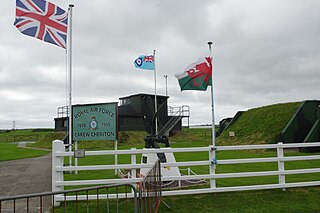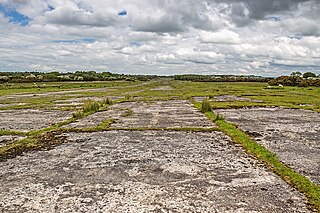
Royal Air Force Chivenor, or more simply RAF Chivenor, was a Royal Air Force station located on the northern shore of the River Taw estuary, on the north coast of Devon, England. The nearest towns are Barnstaple and Braunton.
Royal Air Force Bircham Newton or more simply RAF Bircham Newton is a former Royal Air Force station located 2.1 miles (3.4 km) south east of Docking, Norfolk and 13.4 miles (21.6 km) north east of King's Lynn, Norfolk, England.

Royal Air Force Elgin or RAF Elgin, also known as Bogs of Mayne, is a former airfield operated by the Royal Air Force and located approximately 1.5 kilometres (0.93 mi) south west of Elgin in Moray, Scotland. It opened in 1940 as a satellite airfield of RAF Lossiemouth and was used throughout the Second World War, predominantly by bomber aircraft of No. 20 Operational Training Unit. Towards the end of the war it was used by No. 46 Maintenance Unit, before it closed in 1947. The site was returned to agricultural use, although several airfield buildings and a memorial remain.

Royal Air Force Haverfordwest or more commonly RAF Haverfordwest, is a former Royal Air Force station located 2.1 miles (3.4 km) north of Haverfordwest, Pembrokeshire and 11 miles (18 km) south of Fishguard, Pembrokeshire, Wales.

Royal Air Force Talbenny, or more simply RAF Talbenny, is a former Royal Air Force station located 5.6 miles (9.0 km) north west of Milford Haven, Pembrokeshire and 7.9 miles (12.7 km) south west of Haverfordwest, Pembrokeshire, Wales.

Royal Air Force Carew Cheriton, or more simply RAF Carew Cheriton, is a former Royal Air Force station located near Carew, Pembrokeshire. It was situated 4.7 miles (7.6 km) north west of Tenby.

Royal Naval Air Station Dale is a former Royal Naval Air Station, located 10 miles (16 km) South West of Haverfordwest in Pembrokeshire, Wales. It was operational between 1942 and 1948, being used by both the Royal Air Force (1942–1943) and the Royal Navy (1943–1948).

Royal Air Force Templeton, or more simply RAF Templeton, is a former Royal Air Force station located 9.75 miles (15.69 km) south east of Haverfordwest, Pembrokeshire and 10 miles (16 km) north east of Pembroke Dock, Pembrokeshire, Wales.
Royal Air Force Honeybourne, or more simply RAF Honeybourne, was a Royal Air Force station located 0.6 miles (0.97 km) south of Honeybourne, Worcestershire, England and 4.6 miles (7.4 km) east of Evesham, Worcestershire, England

Royal Air Force Thorney Island, or more simply RAF Thorney Island, is a former Royal Air Force station located on Thorney Island, West Sussex, England, 6.6 miles (10.6 km) west of Chichester and 7.1 miles (11.4 km) east of Portsmouth, Hampshire.
Royal Air Force Bitteswell or more simply RAF Bitteswell is a former Royal Air Force satellite station located 2.0 miles (3.2 km) west of Lutterworth, Leicestershire and 6.1 miles (9.8 km) north of Rugby, Warwickshire, England.
Royal Air Force Silloth, or more simply RAF Silloth, is a former Royal Air Force station one mile (1.6 km) north-east of Silloth, Cumbria, England, and 6.7 miles (10.8 km) south-west of Kirkbride, Cumbria. The station was used by RAF Coastal Command.

No. 1 (Coastal) Operational Training Unit RAF, was a training unit of the Royal Air Force, within No. 17 Group RAF, which was part of RAF Coastal Command. The unit was established during April 1940 by the redesignating of an existing RAF Coastal Command unit, and disbanded during October 1943.

No. 2 (Coastal) Operational Training Unit RAF, was a training unit of the Royal Air Force, within No. 17 Group RAF, which was part of RAF Coastal Command. The unit started operating from late 1940 and disbanded during early 1944.

No. 17 Group RAF was a group of the Royal Air Force which was operational in the last year of the First World War, and throughout the Second World War.
Ferry Training Unit is a former Royal Air Force unit which operated between 1952 and 1958 to train ferry flight pilots. The unit was formed by a series of replacements, disbandments and mergers dating back to 1939.

Coastal Command Anti U-Boat Devices School RAF was a training unit of the Royal Air Force and part of RAF Coastal Command. The unit was established during April 1945 by the redesignating of an existing RAF Coastal Command unit. The unit had several different identities beforehand. It began as the short lived No. 7 Operational Training Unit which only existed during 1940, before reforming in 1942 as No. 7 (Coastal) Operational Training Unit. It disbanded and was redesignated a few more times before becoming the Coastal Command Anti U-Boat Devices School.

Air-Sea Warfare Development Unit RAF (ASWDU) was a research and development unit of the Royal Air Force, within RAF Coastal Command, it was operational from December 1940 and disbanded in April 1970.

No. 5 (Coastal) Operational Training Unit RAF, was a training unit of the Royal Air Force, within No. 17 Group RAF, which was part of RAF Coastal Command. The unit was established during August 1941 and disbanded during August 1945.












